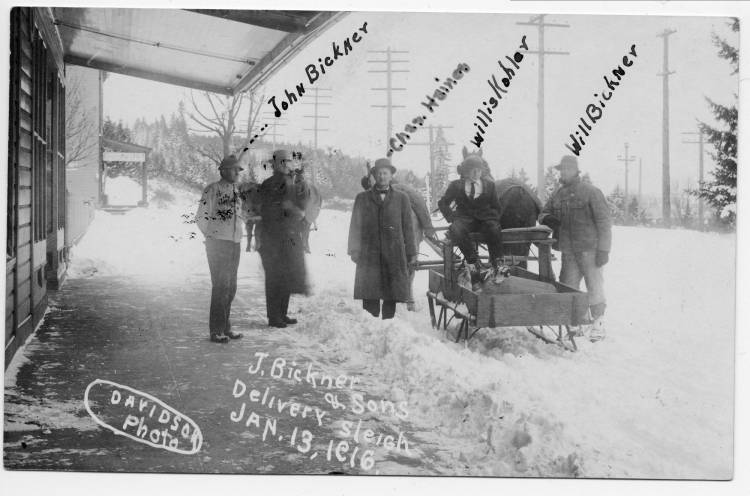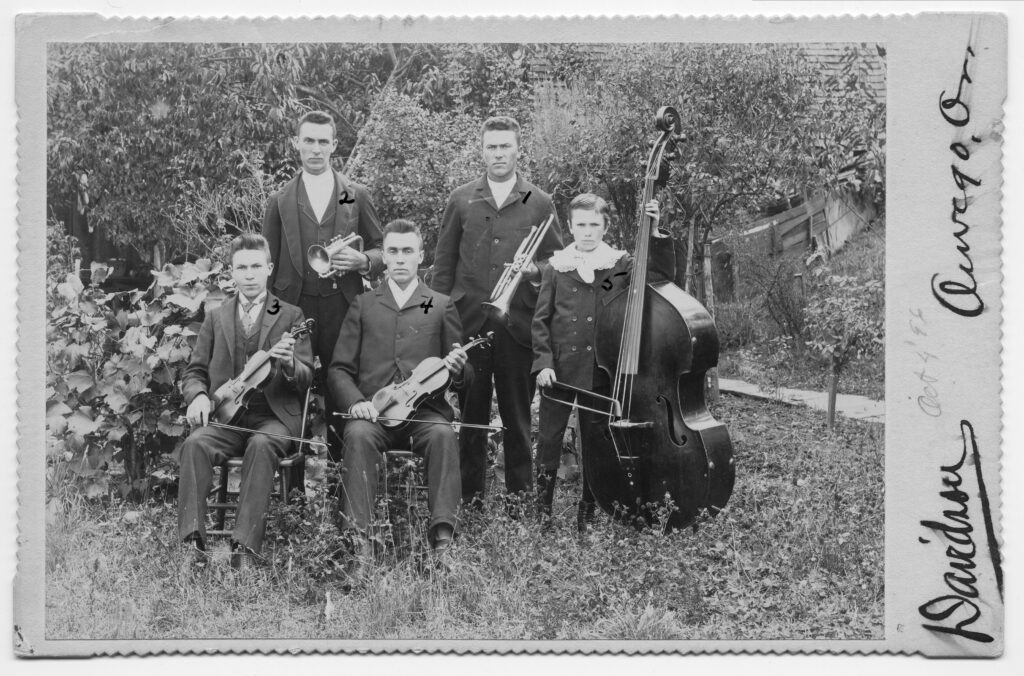Referred to as the “Bickner Boys”, Virginia and Joseph Bickner, Senior’s five sons (Joseph Jr., Henry B., William E., John, Charles) taught themselves to play musical instruments and formed Oswego’s first family quintet orchestra. Joseph played the slide trombone; Henry, the violin, William, the cornet; John, the violin, and Charles, the bass viola. Sisters Mary and Lillian played the piano. Lillian taught herself to play and accompanied her brothers’ orchestra. Mary played for the church choir but whether she taught herself to play is unclear. The Bickner Brothers –and sister – orchestra was extremely popular, receiving many accolades and requests to play dances, recitals, and weddings.

Joseph W. Bickner, Sr. and his wife Victoria, both originally from Prague, came to Oregon from Minnesota in the1880’s. The family settled with Victoria’s sister and brother-in-law; Clara and Henry Gans. Gans owned the general store at the corner of Bickner Street and McVey Avenue in what was then called “South Town’. Joseph Bickner, Sr. bought the general store and living quarters – all one building– from Gans about 1892.
Bickner ran that store until he and three of his sons–John, William, and Charles, bought the Johnson Hotel in “New Town” (now First Addition) on State Street between A and B Avenue. They remodeled the hotel into a general merchandise store and named it J. Bickner and Sons. The lower level contained groceries and dry goods; the balcony contained hardware. To the rear was a barn for three horses, two delivery wagons, and a hayloft. The front of the building, one level, was used to store grain, supplies and housed the refrigerators. Some years later a walk-in refrigerator was installed so that both Bickner and Sons and Bethke’s Meat Market next door could use it. Note: For a short time the Bickners owned two stores.

Joseph Bickner, Sr. died in 1921 at age 78, but the three Bickner brothers kept the store going until Safeway purchased it in 1938. In the years that followed, Safeway moved out of the building; Freda Bain opened a dress shop, which was replaced by Lucille’s – another dress shop. The Tates, owners of Tim’s Germs, purchased the building from the proprietor of Lucille’s and operated their jewelry store upstairs in the building. They leased the street level area to Imperial Flowers and Heads up Stylists. According to Tim and Nadeen Tate, the adjoining section of the building housed an auto parts store.
The third-floor reference department at the Lake Oswego Public Library, has an original Bickner store sign. You’ll find it atop the book shelves on the north-facing wall. I don’t know if this is the very first sign or one made later.
More about the Bickner–and Gans–families can be found in my book History Soup – Stories of Oswego’s Past.

We’re thrilled to welcome Nancy as a contributor to the Palisades Neighborhood Association’s monthly newsletter, where she’ll be serving up fascinating historical stories about Lake Oswego. Get ready to dive into the rich, colorful past of our community—History Soup style! Find out more about Nancy on her website, or purchase her books available on Amazon.
Nancy Dunis is a passionate public historian, dynamic storyteller, and published author with a flair for bringing the past to life. As the founder of History Soup Press, she’s the creative force behind the History Soup book series and The HistoriConnection blog. For over 20 years, Nancy has been sharing captivating historical nonfiction through newspaper columns, blogs, magazines, social media, newsletters, and three compelling books.
With a special focus on barrier-breaking women, infamous men, and unforgettable events, she uses a wide range of audience engagement techniques to make history accessible, exciting, and relevant.


